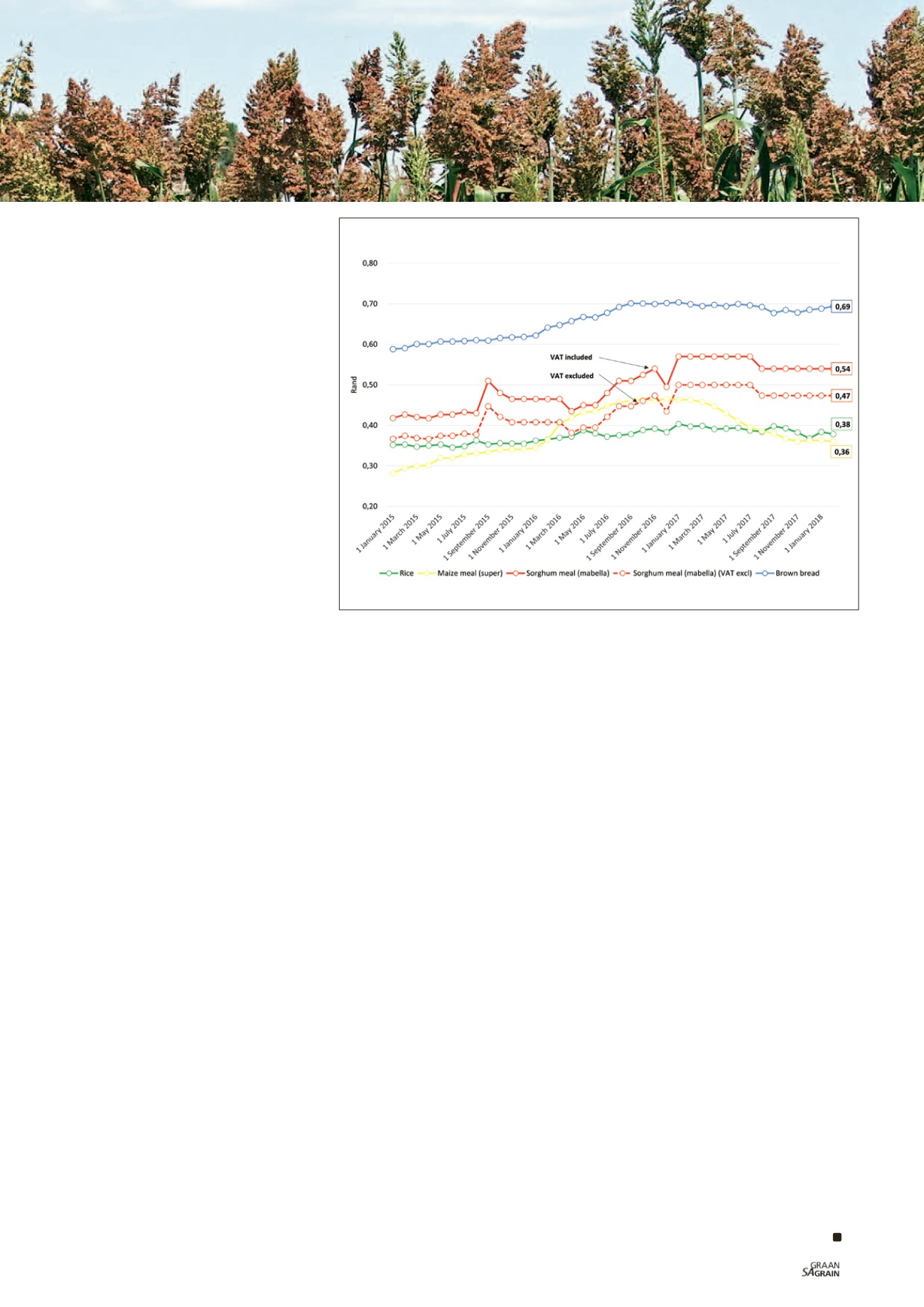

81
August 2018
consumption as malt, sorghum meal and
sorghum rice and is successfully used as
a substitute for maize as an energy source.
Over the past three years the average an-
nual commercial consumption of sorghum
was approximately 171 500 tons, of which
155 600 tons were utilised for human con-
sumption (as malt and meal) and 8 700 tons
for animal feed. The average share of the
food market in total sorghum consumption
over the past three years is approximately
94% - 95%, of which the biggest percentage
is for meal.
Graph 1
depicts total local grain sor-
ghum consumption and production from
1997/1998 to 2018/2019, in marketing sea-
sons. The downward trend in both con-
sumption and production is very worrying
for industry role-players and the downward
trend in consumption has been identified as
one of the single most important aspects
which needs to be addressed to establish
growth in the industry. The annual com-
mercial consumption of sorghum during
the 1997/1998 marketing season was ap-
proximately 266 500 tons. This decreased
with a calculated 115 200 tons to the current
total consumption of 151 300 tons. The con-
cern is that with the present rate of decline,
sorghum may in the near future not be con-
sumed anymore.
The total sorghum production in South
Africa also decreased from 355 000 tons
during the 1997/1998 season to 83 070 tons
in the 2018/2019 production season, which
is the second smallest crop to date. The
smallest crop occurred two season ago
– when South Africa was challenged with
a terrible drought. This constitutes a de-
crease of 271 930 tons during this period.
From Graph 1 it is clear that sorghum pro-
duction in South Africa is also in a constant
downward trend.
Nutritional value
Table 1
displays the nutritional values of
sorghum compared to substitute products.
The nutritional values per 100 g of sorghum
porridge (Mabella) are compared with those
for 100 g of rice, super maize meal, bread,
millet and potatoes.
Sorghum has additional nutritional benefits
compared to the other products – it con-
tains the highest zinc and iron per serving
which proves that sorghum has numerous
health benefits and has a big role to play in
a balanced and diverse diet (BFAP, 2018).
Graph 2
shows the cost (R) per 100 g
serving unit of sorghum meal compared to
super maize meal, bread and rice. It is again
clear that sorghum meal is more expensive
compared to the substitute products due
to the VAT on sorghum meal. The graph
also illustrates how the price of sorghum
meal will compare against the other pro
ducts in case the VAT on sorghum were to
be removed.
Diversify within the
same food basket
The economic climate is an important de-
terminant of consumer demand preferen
ces and consumers easily switch to
cheaper substitute products such as maize
meal and rice. It is important to broaden
the product range for consumers in lower
income groups. Sorghum is a good alterna-
tive product.
With the removal of the VAT, sorghum and
sorghum products will be able to compete
against substitute products in the zero-
rated value chain. As sorghum products
currently need to compete with substitute
products on a price basis, with the VAT re-
moval consumers will have a bigger base of
products to choose from.
It is expected that with the removal of the
VAT, sorghum’s competitiveness will im-
prove compared to that of other products
and have a positive impact on the consump-
tion of sorghum as a substitute product.
Sorghum trade
perspective
South Africa used to be a net exporter of
sorghum, but is, specifically the past few
years, becoming more dependent on im-
ports to fulfil our local demand. Every sea-
son when insufficient volumes of sorghum
is locally produced South Africa needs to
imports sorghum – currently mostly from
the USA. The ultimate aim should be to
be ‘self-sufficient’ and to have a good bal-
ance between local consumption and local
production. Hopefully, with the removal of
the VAT, this situation will change.
Conclusion and appeal
Although Grain SA hopes that sorghum
will be zero-rated, we believe that the re-
moval of the VAT would be of advantage not
only to low-income consumers, but to all
South Africans as sorghum is an indigenous
crop to Africa and is mainly used as a tradi-
tional staple food by many South Africans.
Grain SA applied for the zero-rating of sor-
ghum and sorghum meal in order to grant
the industry the opportunity to revitalise
itself and to boost the consumption of the
product. The successful turnaround of the
sorghum industry, with government sup-
port, may prevent further job losses and
economic development opportunities. The
outcome of this will be communicated.
Graph 2: Cost per single serving unit, 100 g (R).
Source: BFAP, 2018
Grain SA/Sasol photo competition
















